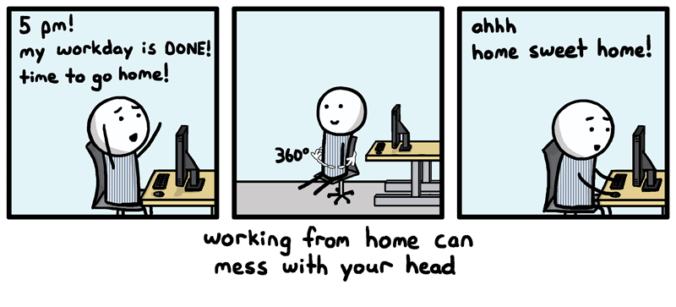We at Network Right understand that the world of technology is ever-evolving. One benefit of that is the tools that allow us & our clients to work remotely and outside of the office. Whether it’s from home, at your local coffee shop, and so on. Given the recent situation with COVID-19 we understand our client’s desire to implement mandatory work from home policies. This transition for some can be tough & a new environment so we wanted to help & share our tips to working from home or remote regardless of the situation.

All while keeping in mind everyone works differently. This isn’t to argue what is a more productive workflow or setup rather shed some potential tips that can help you ease into this transition or integrating it into your own routine.
1. Designate a “work” area
This varies depending on your environment but for those working from home if at all possible we recommend designating some sort of area for work. Think of this area as your personal workspace/desk at home. It can be a desk or table, living area, and for some let’s be honest maybe your bed (though we’d advise against it but to each their own). The idea here is to create a separation of our typical living space to an area we work in. Having even the slightest separation can help you mentally surpass the hurdle that despite being at home or remote your here to work. For others, this may mean your local coffee shop, a co-working space, and the list goes on. The importance here is to create a mental & physical separation that this is your workspace. Make it your own! This could mean having your optimal set up at your desk that fits your workflow, a great office chair, make the environment fit your needs.

While more monitors may not equal more productivity, it’s your setup have fun with it.
2. Maintain Regular Hours
Set a schedule and make sure you relay that schedule with your team, that way there isn’t any miscommunication between your teammates. This may be uncomfortable to communicate your hours to your team at the beginning; however, it will be extremely important for your team’s productivity. It can be very frustrating to miss a deadline because you are waiting on a deliverable from another team member who is working unknown hours. 8 hour days are a good rule of thumb with 3-4 hours of intense focus, and the rest dedicated to meetings, calls, and other collaborative functions. Setting hours for yourself will also help you create a structure for your workday and ensure efficiency throughout your day. Another benefit of having a set schedule is that it will help maintain your work balance, being able to differentiate your working hours and non-working hours.
3. Video Conferencing Tips
One part of working remotely is we get to figure out all the meetings that could’ve simply email… jokes aside teleconferencing will likely be a big part of your work routine when offsite. Here are some tips to help navigate those Zoom, Google Meet, (insert service here) conference calls.
-
Be mindful of your environment. Especially in cases where video calls are concerned. A plain background or wall can help to eliminate the everyday occurrences that may pop up when working from home pets, family members & so on strolling into the frame. Additionally knowing what’s ongoing around you as far as your setup. Working from cafes can be great but at times distracting when on conference calls due to the ambient noise, while most software does its best to mitigate this sometimes a simple rule of muting your mic unless you need to speak is a good rule of thumb.
-
Headphones if possible. It can be your apple standard earbuds or your fancy noise-canceling Bose. To help eliminate echo, feedback, and so on having a pair of headphones if possible will help you focus on what’s ongoing in the calls & minimize audio feedback issues.
-
Third-party equipment. For those who may be permanently remote, it may be a worthwhile investment to expand beyond your laptop’s/desktops built-in microphone. It can be a standard headset, USB mic, webcam the list goes on. A little investment can go a long way.
-
Personalize it. While 100% not mandatory by any means. Conferencing applications like Zoom allow for virtual backgrounds. While it won’t improve your workflow or quality of calls it may improve the fun aspect. Use it at your discretion.
-
Be mindful of home or remote internet connection. While this goes for the internet as a whole it applies even more so for meetings. Not every home or even public location will have the connection speed your office may have. So being aware that at times video calls may not be optimal where an audio call can suffice & so on depending on your connection.
4. Utilize your VPN
VPN or Virtual Private Network is more important than ever when it comes to remote settings. Making sure you use either your company-required VPN or personal VPN service when accessing any servers, websites, or internal resources from your company. Virtual private networks create a secure way to access company data when you are not at the office. This is even more important if you are working off public wifi such as a cafe, library, airport, or public area.
For any help looking into a great VPN provider for personal or company-related use don’t hesitate to reach out.
5. Take Breaks!
A tip that can’t be stressed enough. While working from home it can almost become easier to lose yourself in your work/time. While this helps much focus on the task at hand it’s also important to monitor & realize when to take breaks. Simply standing up every 20-30 minutes to take a quick walk, take your eyes off the monitor, and many other practices are ones you should follow even if not working from home/remote. Given the remote circumstance your not physically getting up & moving about as you would in an office. So physically standing up & making the effort to take a quick break is more important than ever.
6. Socialize & Collaboration
While working from home or remote has a lot of benefits the biggest drawbacks lie in the lack of socialization & physical collaboration. Thankfully technology & tools used throughout companies make this a bit easier. Ensuring your companies have certain apps & tools available at your disposal.
-
Slack (For communication/collaboration) maybe even think to include a #Remote or #WFH channel so those outside the office can continue to feel a sense of community
-
Teleconferencing software. There’s a variety of solutions here & will vary on your company but a great idea for teams not use to the work from home or remote scenario may consider setting up a call for users to essentially hang out while they work remotely. A way to feel a sense of companionship & easy access to others despite not being in office.
-
Keep in mind work from home policies will vary from company to company. So different rules may apply to your scenario but you should be available through whatever channels your company uses in the event someone needs to reach out to you. It can be e-mail, slack, etc. Being mindful that just because you’re not on-site you should be available as you would in an office setting.
-
Calendars! Keeping your calendar up to date is more important than ever in a remote setting. This allows your employees to know when you’re busy, booked, and what not to better understand when they can get ahold of you if needed.
7. Minimize Distractions
The benefit of working from home or remote is also its curse. While the freedom of working remotely offers certain freedoms it can also lead you to veer from your work. Helping to minimize & better manage these go a long way. First, up the digital distractions, this includes but isn’t limited to social media, streaming service, and so on. Now while these can certainly be used in a productive & or multi-tasking manner it’s best to decide what is conducive & or obtrusive to your workflow. For some music in the background and the freedom to play it out loud helps them get into their workflow. While for other Twitter, Facebook, and so on can just lead down a rabbit hole of wasted time.
-
Start by defining your distractions
-
Block them if necessary (Tools like “Work Mode” for chrome will block social media or at least make it that much of an extra step to access)
-
Full-screen mode is a great way to focus on your task at hand. Maximize your windows or take advantage of your OS full-screen capabilities.
-
Allow for some lee-way. Again if permitted you can enjoy a video in the background or music whatever it may be doing so as long as it doesn’t compromise your work
That said we also have to factor in the physical world & its distractions
-
As alluded to in earlier tips, some things we can’t control such as our space or the ambient noise, the people around us so deciding what’s best for your given workflow. Finding the best space for you to handle work and perform daily tasks such as video calls and so on
-
Putting people on notice. While it doesn’t always work out, the mere act of reaching out to those at home (family, friends, etc) to let them know your working remote and or to be aware during important calls and so on goes a long way
At the end of the day, you’ll know what works best for you but the better you define & prepare for said distraction the more optimized your work environment will be.
8. Proactively Communicate
Let’s face it, not being able to stop by a co-worker’s desk or ask a quick question in person can be quite a change for some people. While some people are used to doing that, new habits have to be formed when remote. There is a need to fight assumptions when it comes to who did what and if they did say task. This is where communicating effectively and proactively comes into play. When working from home, it can be difficult to gauge someone’s availability at any given moment. Some questions pop up like:
-
Where is Joe?
-
Is Linda free right now?
It is vital in any team or department to communicate as much as possible when remote. Here are a few recommendations in how to communicate proactively, and effectively:
-
Set Slack status to let people know when you’re available, out for a walk, grabbing a bite to eat, or on a phone call.
-
Integrate your Office365/Google Calendar to Slack so it auto-updates your Slack status to “in a calendar meeting” when an event occurs.
-
Send out periodic updates on what you are working on to your team. Let them know if you’re pacing for on-time competition, or if you need some more time, or most importantly, if you need some support.
9. Know Your Technology Resources
Most companies have a variety of software applications and resources available to their employees. It is important to know what software applies to what specific business function. For example:
-
Slack – Used to communicate with team members organization-wide. Can video/audio chat and set statues to show availability.
-
Zoom – Used for video conferencing in and outside the organization.
-
Confluence – Used for a company intranet.
-
IT Helpdesk – Used to submit any IT requests, whether that be software or hardware.
10. Make the Experience Your Own
Some people such as myself find it useful to physically change as if I was going into an office to mentally switch into a work mode, others prefer to stay in their PJ’s & comfortable attire. Some prefer to work from a full desk setup others find the on-go & ruckus of a public place to be more ideal. At the end of the day, the experience is your own & there is no right answer. You need to figure out what works for you & helps ensure your productivity despite the lack of physical presence in the office. Some thrive in remote settings while others don’t & that’s okay. There are certain benefits that come with it and realizing those while not allowing them to dominate your workday is important. Ensuring you minimize distractions and understand your still “working” despite the lack of co-workers & accountability that may surround you in an office setting. Mix it up & make it your own.
Ultimately everyone has their own remote and work from home tips. As this remote workforce becomes more and more relevant this day in age these are all things you can keep in mind. In one-off scenarios where a large part of the workforce is mandated to such situations, these are good practices to start with. As always you know what works best for you & your work style above all that should always be accounted for. So start out by using some of the above tips & seeing what your company culture has and or lacks in terms of support for remote employees & settings. It’s about ensuring you’re at optimal productivity given your circumstances and that despite not being in the office you feel a sense of drive and inclusiveness with your counterparts. That while it may not be a scenario everyone is fortunate enough to have, at times it comes down to defining what works & what doesn’t and understanding if possible it may just be best to come in to collaborate, meet, and so on with your clients or company in person.
So get to work!


